How to spot them, and what to do about them
By Joseph Koripsky
Last fall, for the first time, I observed numerous adult Spotted Lanternflies (SLFs) and egg masses at Long Beach, upon Ailanthus trees (aka the Tree-of-Heaven, which is also an invasive species from China), and so began their lifecycle in Stratford, as well as my decision to study them.
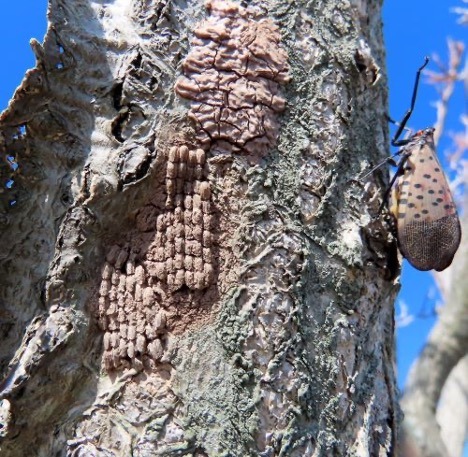
The adults died off in winter, but left eggs behind. In spring, the over-wintering eggs hatched into the first of four nymph stages. Since late May I have been finding some nymphs at Long Beach, but in lower numbers than I expected. However, I have observed shocking numbers of SLF nymphs on grapevines around town.
Grapevines seem to be the focal point of the heaviest infestations that I have observed.
Residents should inspect grapevines for nymphs at this time. I don’t have authority to conduct unlimited searches, but with citizens’ help it would be nice to compile a distribution map of SLF sightings in town…a great kid’s summer science project.
The accompanying images can serve as a guide to identifying them.
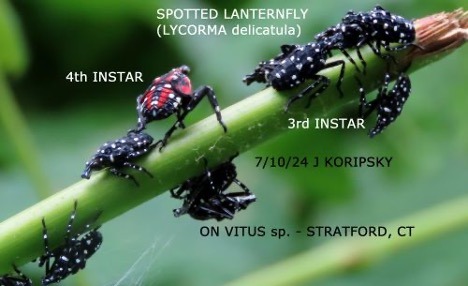
On July 9th, I started finding 4th stage nymphs. This is the last stage before they metamorphose into the egg-laying adult stage.
These nymphs have a red, rather than black coloration, with white spots. A closer inspection will reveal the presence of tiny stub-wings. It seems that as the nymphs mature, they become more evasive. This makes them more difficult to catch, or kill without the use of insecticides that cause collateral damage.
At this time, it is uncertain how North American predators will respond to this newcomer.
In native China, SLF numbers are kept in check by a wasp, which preys upon them.
Interestingly, Penn State U.- Entomology reports that citizen-scientists have provided some photos of SLFs being eaten by Cardinals, Catbirds, Bluejays, Garter Snakes, and Koi Goldfish. It’s difficult to know what their place in our ecosystem will be in the long run.
There’s more—SLFs are colorful and brilliant. In the animal world, flashy, unmistakable colors usually advertise that an unpleasant experience awaits any potential predator.
It’s a visual warning to them to avoid contact due to toxicity, bite, sting, or other form of danger. It’s a way of saying, “Leave me alone. If you mess around, you’ll find out the hard way.” A few examples of this “warning-coloration” include: Monarch butterflies, Yellow jackets, Bumble bees, Dart Poison Frogs, skunks, and there are many more. Sometimes for an insect’s warning to be viable, a specific diet is required. Specific dietary requirements may not be found in the SLFs new territory. There’s much to be learned about how SLFs fit into this scheme.
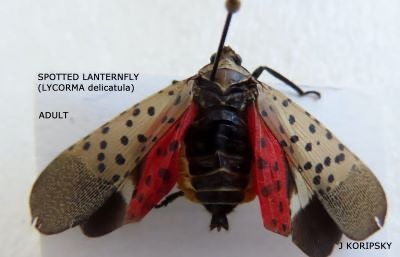
Lastly, SLFs don’t bite or sting or gobble up leaves or stems. They possess mouth parts that suck sap from the host, though usually not in sufficient quantity to kill the host.
Damage is due to copious amounts of sticky excrement which coats the plant’s stems and/or leaves. This substance contains sugars and other nutrients from the plant’s sap.
It’s called “honeydew”, which, in turn attracts a mold fungus which harms the plant’s photosynthesis ability.
The name “lantern fly” comes from an old (17th century) belief that they could illuminate their snouts. It’s not true.
That’s a little bit about this attractive, interesting, potentially destructive and invasive insect, that is making it’s debut in our town.
We’ll be learning more as time passes.
Editor’s note: A one-to-one mix of water and a liquid dish soap, such as Dawn, used in a spray bottle will kill the SPFs, as well as the eggs. Spraying them with vinegar or a mix of vinegar and water will kill them, but, as noted above with insecticides, can also damage the plants.
In addition, remove any Tree of Heaven sprouts that you may find in your yard. They are a rapidly growing plant that can reach eight feet in one year.
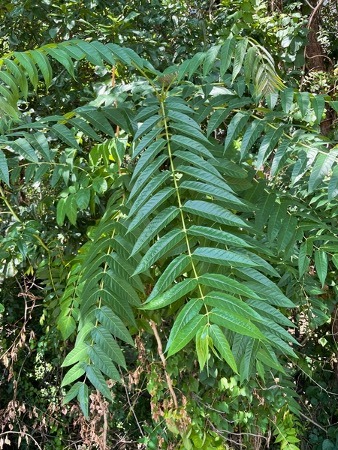

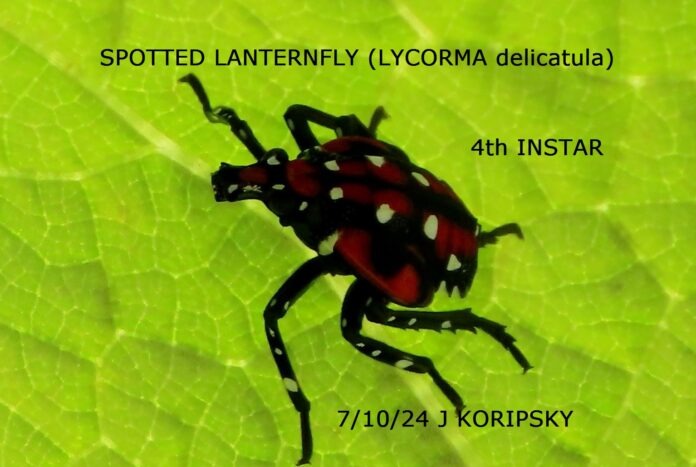
Extremely helpful article, thank you! Please provide more information as available!
I’m grateful for Joseph’s alert to this growing problem. I’ve found several nymphs on Tree of Heaven sprouts in my gardens, and can attest to the effectiveness of the Dawn/water mix. Just be sure the spray bottle you use has a big enough opening to get a good dose on the first & second squirt. Otherwise, just dump some of the mix on the nymph.